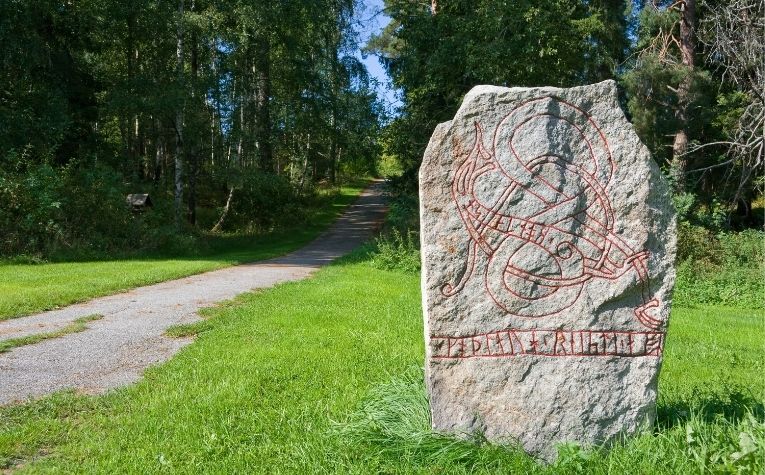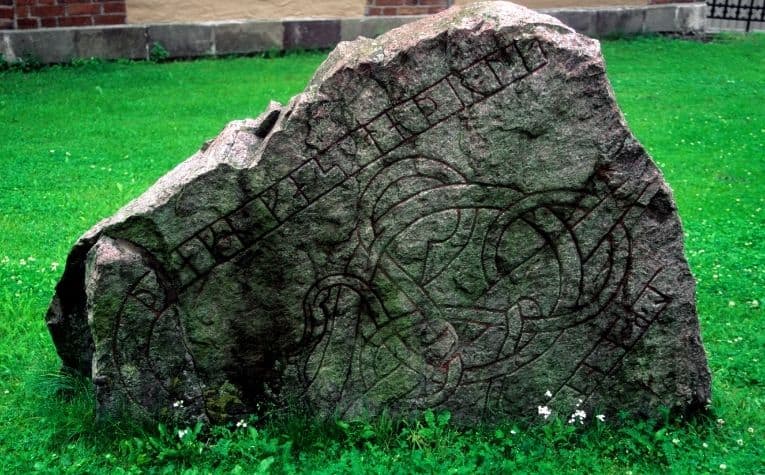
The Viking people and their way of life is fascinating to many people. That modern popular culture is interested in the Vikings is evidence of people’s fascination with them, but sometimes portrayals of them are more stereotypical than factual. One of the common questions people ask about the Vikings is, did they have a written language? The Vikings had a written language called Futhark. Even though that name may not be familiar to many people, when the characters of the language are seen people often realize they have seen some of them before. Futhark is a type of rune, which the Viking used to write things such as poetry and memorials to the dead. Like most ancient groups, the Vikings’ written language reflected the world around them. The environment of ancient Scandinavia had a natural environment that included mountains and hills, rivers and lakes, and the sun and snow. The Viking language wasn’t merely a communication tool, it reflected their values, beliefs, and culture as well. Did the Vikings have writing on their bodies? See How the Vikings Got Tattoos (and Why) to learn more.

Like most people groups of the ancient and modern world, the Vikings had a written language as well as an oral language. Their was a relationship between the two forms of communication, yet their uniqueness is defined, in part, by how the written and oral forms are different than each other. Written language: The written form of Old Norse is a runic alphabet. [1] The runic alphabet comprises a series of vertical, horizontal, and diagonal lines that together form an image with a particular meaning. Runes Merriam-Webster defines runes in relation to their Germanic roots:
| Merriam-Webster: A rune is “any of the characters of any of several alphabets used by the Germanic peoples from about the 3rd to the 13th centuries.” [2] |
| Dictionary.com: A rune is “any of the characters of certain ancient alphabets, as of a script used for writing the Germanic languages, especially of Scandinavia and Britain, from c200 to c1200, or a script used for inscriptions in a Turkic language of the 6th to 8th centuries from the area near the Orkhon River in Mongolia.” [3] |
| Cambridge dictionary: A rune is “any of the letters of an ancient alphabet cut into stone or wood in the past by the people of northern Europe, or any similar mark with a secret or magic meaning.” [4] |
Phoneme Each runic letter is a sound or phoneme. Various combinations produced different sounds that when combined had unique meanings.
| What is a phoneme? In phonology [i.e. the study of how language sound] and linguistics, a phoneme is a unit of sound that distinguishes one word from another in a particular language. [5] |
Runic letters were etched right to left or left to right. The earliest known runic writing is in Denmark dating to 160 A.D. and is called the Vimose comb. Runes were not solely used by the Vikings, but were a communication tool used by many Germanic languages from 160 A.D. to about 1200 A.D. (Also see Why Did the Vikings Say Skol?) The Vimose Comb The Vimose comb is oldest known runic inscription found to date. It was discovered on the island of Funen, Denmark. The runic inscription belongs to the earliest phase of runic use called Elder Futhark and dates to approximately the second century A.D. A lot of people wonder what the Vikings looked like. See The Viking Dress Code: What They Wore and How to see more.

Elder Futhark has 24 letters and gets its name from the combination of the first six letters of the alphabet (“th” being one letter).
It was the written script used by the Germanic languages like Proto-Norse, Proto-Germanic, and Proto-English. It’s thought to have evolved from the Greek alphabet as they are similar in appearance.
Only 400 surviving pieces with Elder Futhark exist today. The majority of items with inscriptions were wood and therefore, over time, did not survive.
Inscriptions have been found on coins, jewelry, combs, armor, and most famously rune stones. [6] Why runes are etched into these items is not entirely known.
The Younger Futhark is the written language of the Vikings. The Vikings adopted the Futhark runes but made changes.
They eliminated eight letters and refined the others to be easier to use.
As in the Old Norse oral language, Younger Futhark had regional differences, and pronunciations varied.
Within Younger Futhark, two different variations were used most often:
The writings of the Viking Age are a mystery due to the wide variations in Futhark.
Once the Younger Futhark became popular, letters were being pronounced in several ways. Without the context of the etchings, the meaning of the surviving pieces stays a mystery.
How far west did the Vikings travel? See The Vikings in America: The Evidence to see more.

Evidence of a Viking written language is best showcased in the rune stones from that era.
Rune stones are the best evidence because they are in good condition and number in the thousands. [7]
A runestone is as it sounds: a large stone etched with runes.
These stones were found in well-traveled places and told the story of a great individual who needed remembering. (Also see Traditional Viking Art: 7 Styles of the Period)
The stones are inscribed with the story of a person who died in battle, was a king or queen, or did a great deed.
They don’t rest at the place of the person’s burial site like a headstone. Instead, they are a memorial erected by a family member.
The Viking runestones are large and spread throughout Scandinavia.
The most famous of them is likely the Jelling Stone, erected by Harald Bluetooth in Denmark, to celebrate his father Gorm the Old. [8]
The runestones are dispersed among Sweden (about 3000), Denmark (250), and Norway (50). [9]
The largest grouping of runestones in one location is referred to as the England runestones located in Sweden.
These stones tell the story of the Vikings traveling to the English Isles for plunder and reward. Other stones with Viking runes describe travels to Greece and the Middle East.
As mentioned earlier, Old Norse is considered the religion of the Vikings, but it’s also the term for the oral language. [10]
Old Norse is a Germanic language originating in the Proto-Norse language starting in the 7th century.
Today, it’s the father of the Icelandic, Norwegian, Swedish, and Danish languages.
It was used in regional forms in places of Viking conquest, such as France, Scotland, Ireland, and Finland. By the 15th century, Old Norse as an oral language had dissolved into its descendants.
The Vikings used a written language in the form of Younger Futhark and they told great stories through poems and the famous runestones.
These Scandinavian people were more than barbarians and murderers.
They celebrated life and left behind written evidence for history to remember for thousands of years.
The time of the Vikings is considered to have begun at 790 A.D. and lasted for approximately 300 years.
The spread of Christianity is considered to be the beginning of the end for Viking dominance in Europe.
Christianity assimilated the Scandinavians into their way of thinking and writing around 1066 A.D.
Viking voyages continued after that date, but the frequency decreased.
Scandinavians began to adopt the Christian religion, and artifacts start to show the influence of Latin.
The Viking Age doesn’t end in one battle, but people’s beliefs change over time.